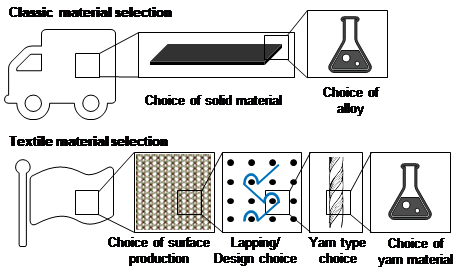Textile Development (TED) Method – a new method for the sustainable development of new textile products
DOI:
https://doi.org/10.25367/cdatp.2024.5.p120-130Keywords:
product development, methodology, textile product, technology selection, pattern selectionAbstract
The textile field is diverse and encompasses products intended for technical and non-technical applications. The product diversity in the textile domain has led to various product development approaches. This paper describes a product development method for textile products that is generally applicable. In the so-called Textile Development (TED)-Method, the textile surface manufacturing process is determined in the product development process. In this way, it is possible to develop in an open, target-oriented way and independent of an existing supplier or machine park. By using correlation matrices, a broad design field is considered and specific solutions are extrapolated that lead to the desired product without lengthy iteration series. Thus, the TED-Method additionally represents a resource-saving product development without renouncing a broad design field. Three different development examples of the TED-Method are presented, thus demonstrating the open and comprehensive use of the method
References
Verein Deutscher Ingenieure (Ed.) VDI-Richtlinie 2221 Blatt1: Entwicklung technischer Produkte und Systeme. Beuth Verlag GmbH (Berlin), 2019.
Hahn, J. Stand der Wissenschaft. In Hahn, J. Eigenschaftsbasierte Fahrzeugkonzeption 1. Ed. Springer Fachmedien Wiesbaden (Wiesbaden), 2017, pp. 5 42.
Verein Deutscher Ingenieure (Ed.) VDI 2206: Entwicklungsmethodik für mechatronische Systeme. Beuth Verlag GmbH (Berlin), 2004.
Hering, E.; Schloske, A.Quality Function Deployment (QFD) Methode zur effizienten Produktentwicklung orientiert am Kunden unter Berücksichtigung des Wettbewerbes.Springer Vieweg (Wiesbaden), 2022.
Preußig, J. Agiles Projektmanagement Agilität und Scrum im klassischen Projektumfeld. Haufe-Lexware GmbH & Co. KG (Freiburg), 2020.
textileblog (Ed.) Product Development Process in Garment Industry. Dhaka, Bangladesh. https://www.textileblog.com/product-development-process-in-garment-industry/ (accessed 2022-11-03).
Rethlefsen, M. L., Kirtley, S., Waffenschmidt, S., Ayala, A. P., Moher, D., Page, M. J., & Koffel, J. B. PRISMA-S: An extension to the PRISMA Statement for Reporting Literature Searches in Systematic Reviews. Systematic Reviews 2021, 10, 39; DOI: https://doi.org/10.1186/s13643-020-01542-z
Moretti, I. C.; Braghini Junior, A. Reference model for apparel product development. Independent Journal of Management & Production 2017, 8, 232–262.
May‐Plumlee, T.; Little, T. J. Proactive product development integrating consumer requirements. International Journal of Clothing Science and Technology 2006, 18, 53–66.
May-Plumlee, T.; Little, T. J. No‐interval coherently phased product development model for apparel. International Journal of Clothing Science and Technology 1998, 10, 342–364.
Pitimaneeyakul, U.; LaBat, K. L.; DeLong, M. R. Knitwear Product Development Process: A Case Study. Clothing and Textiles Research Journal 2004, 22, 113–121.
Wu, C. S.; Wu, Q. Y. Redesigning the Apparel Product Development Process Based on the No-Interval Coherently Phased Product Development Model. Advanced Materials Research 2011, 331, 603–606.
Lottersberger, A. Design Driven Innovation for Textile Industry. Advanced Materials Research 2011, 331, 730–734.
Lee, C. K. H.; Tse, Y. K.; Ho, G.T.S.; Choy, K. L. Fuzzy association rule mining for fashion product development. Industrial Management & Data Systems 2015, 115, 383–399.
Zhou, H. L.; Yuan, R.; Dong, L. An Analysis of Apparel Products Development Process Model. In From the Prospective of Integrated Design Applied Mechanics and Materials 2012, 215-216, 626–631.
Büsgen, A. New product development in interior textiles. In New Product Development in Textiles; Horne L., Ed.; Sawston: Woodhead Pub, 2012, 978-1-84569-538-5
Arango, J. A.; Castrillón, O. D.; Giraldo, J. A. Optimal development of textile products using Genetic Algorithms. 15th World Multi-Conference on Systemics, Cybernetics and Informatics, Orlando, FL, 19-22 July 2011, 2011.
Beer, M. S. Analysis of the influence of 2D weft knitting process parameters on fabric characteristics for sport shoe uppers. Shaker Verlag GmbH (Aachen), RWTH Aachen, 2018.
Schrank, V. Cost efficient production process of automotive interior textiles using weft knitted spacer fabrics. Shaker Verlag GmbH (Aachen), 2018.
Bettermann, I.; Löcken, H.; Greb, C.; Gries, T. Applying the TED method for the development of novel satellite reflector surface. In The Fiber Society; KU Leuven (Ed.): Abstracts / The Fiber Society 2022 Spring Conference: Fibers for a Greener Society; From Fundamentals to Advanced Applications, May 30–31 and June 1, 2022, Leuven. - Ft. Meade, MD : The Fiber Society, 2022
Beer, M.; Schrank, V.; Gloy, Y.-S.; Gries, T. Systematic development of technical textiles. IOP Conference Series: Materials Science and Engineering 2016, 141, 12005.
Bettermann, I. Development of a spacer warp-knitted reflector surface for telecommunications satellites. Unpublished PhD thesis, RWTH Aachen University, 2023.
Datashvili, L.; Baier, H.; Schimitschek, J.; Lang, M.; Huber, M. High Precision Large Deployable Space Reflector Based On Pillow-Effect-Free Technology. American Institute of Aeronautics and Astronautics: 48th AIAA/ASME/ASCE/AHS/ASC Structures, Structural Dynamics, and Materials Conference, Honolulu, Hawaii, 23-26 April 2007, 2007.
Bettermann, I.; Löcken, H.; Greb, C.; Gries, T.; Oses, A.; Pauw, J.; Maghaldadze, N.; Datashvili, L. Review and evaluation of warp-knitted patterns for metal-based large deployable reflector surfaces. In CEAS Space Journal 69 (2022)1–2, 2022, p. 109.
Scialino, G. L.; Salvini, P.; Migliorelli, M.; Pennestrì, E.; Valentini, P. P.; Klooster, K. van’t; Santiago Prowald, J.; Rodrigues, G.; Gloy, Y.: Structural Characterization and Modeling of Metallic Mesh Material for Large Deployable Reflectors; In: ESA Conference Bureau (Ed.): 2nd International Scientific Conference “Advanced Lightweight Structures and Reflector Anten-nas”, Sheraton Metechi Palace Hotel, Tbilisi, Georgien, 1.-3. October, 2014; 978-9941-0-7008-2
Bettermann, I.; Raina, A.; Gries, T.: Selection and Characterisation of Warp Knitted Textile Materials used for Reflector Antennas on Communications Satellites; In: The Textile Institute (Ed.): The 91st Textile Institute World Conference, Leeds, UK, 23.-26. July, 2018
Bettermann, I.; Löcken, H.; Greb, C.; Gries, T.; Pauw, J.; Oses, A.; Maghaldadze, N.; Richter, L.; Dufour, L.; Datashvili, L. Presentation of a Demonstrator of a new type of Reflector Surface for large deployable Reflector Antenna. Deutscher Luft- und Raumfahrtkongress, 27.-29. September 2022, Dresden, 2022.

Downloads
Published
How to Cite
Issue
Section
License
Copyright (c) 2024 Isa Bettermann, Debolina Mukherjee-Kleiber , Rahel Heesemann, Thomas Gries

This work is licensed under a Creative Commons Attribution 4.0 International License.





